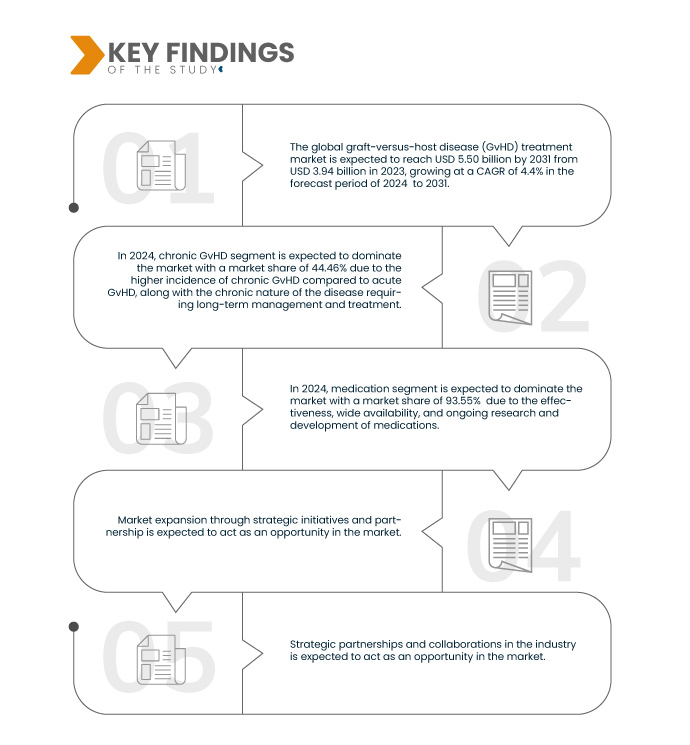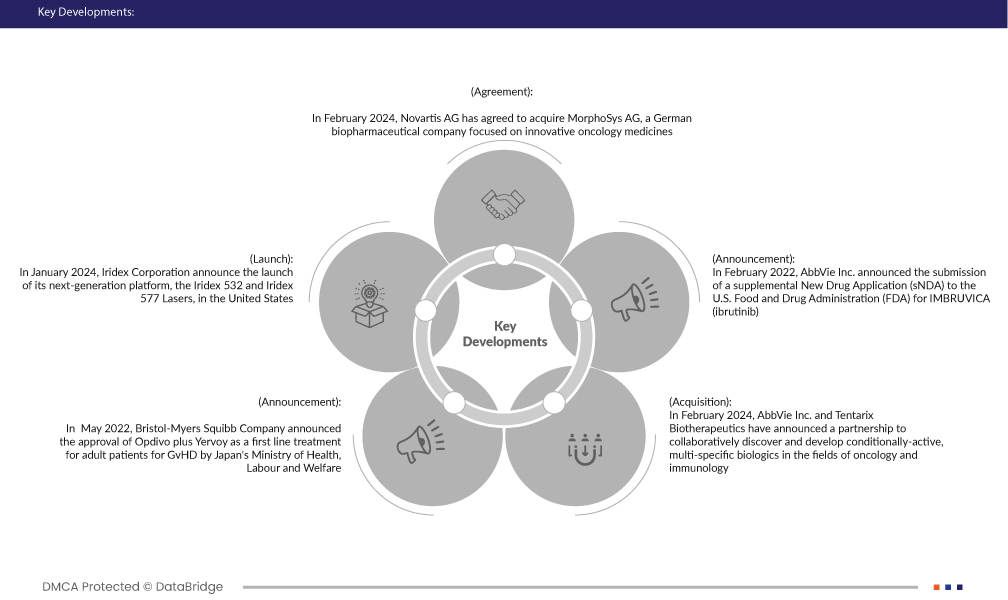Graft-Versus-Host Disease (GvHD) is a condition that can occur after a stem cell or bone marrow transplant in which the newly transplanted donor cells attack the transplant recipient's body. This immune response can cause a variety of symptoms and complications, ranging from mild to severe. GvHD is a significant concern in transplant medicine and requires careful management.
Graft-Versus-Host Disease (GvHD) treatment refers to the various medical interventions used to manage and alleviate the symptoms of GvHD. These treatments aim to suppress the immune response of the donor cells against the recipient's tissues and organs. Common treatments for GvHD include immunosuppressive medications, such as corticosteroids, as well as other medications that target specific aspects of the immune response. In severe cases, more intensive therapies, such as photopheresis or other immune-modulating therapies, may be used. The choice of treatment depends on the severity of GvHD and other factors specific to the individual patient.
Access Full Report @ https://www.databridgemarketresearch.com/reports/global-graft-versus-host-disease-gvhd-treatment-market
Data Bridge Market Research analyses that the Global Graft-Versus-Host Disease (GvHD) Treatment Market is expected to reach USD 5.50 billion by 2031 from USD 3.94 billion in 2023, growing at a CAGR of 4.4% in in the forecast period of 2024 to 2031.
Key Findings of the Study
Increasing Incidence of Hematopoietic Stem Cell Transplants (HSCT)
The increasing incidence of hematopoietic stem cell transplants (HSCT) is a significant driver for the demand for graft-versus-host disease (GvHD) treatment. This trend is primarily fuelled by the growing prevalence of blood cancers, such as leukemia, lymphoma, and myeloma, which often require HSCT as a treatment option. Additionally, other hematological disorders, such as aplastic anemia and certain genetic disorders, also necessitate HSCT for disease management.
Report Scope and Market Segmentation
|
Report Metric
|
Details
|
|
Forecast Period
|
2024 to 2031
|
|
Base Year
|
2023
|
|
Historic Years
|
2022 (Customizable to 2016-2021)
|
|
Quantitative Units
|
Revenue in USD Billion
|
|
Segments Covered
|
Treatment (Medication and Therapy), Type (Chronic GvHD, Acute GvHD, and Prophylactic), Gender (Female and Male), Age (Adults and Pediatric), Method of Administration (Oral, Intravenous, Topical, and Others), End User (Hospitals, Transplant Centers, Institutes and Specialty Centers), Distribution Channel (Direct Tender, Retail Sales and Others)
|
|
Countries Covered
|
U.S., Canada, Mexico, Germany, France, Italy, U.K., Spain, Belgium, Russia, Switzerland, Denmark, Rest of Europe, China, Japan, Australia, South Korea, India, Malaysia, Singapore, Philippines, Indonesia, Rest of Asia-Pacific, Brazil, Argentina, Rest of South America, South Africa, Saudi Arabia, U.A.E., Kuwait, Bahrain, and Rest of Middle East and Africa
|
|
Market Players Covered
|
Bristol-Myers Squibb Company (US), AbbVie Inc (US), Novartis AG (Switzerland), Janssen Global Services, LLC (US), MALLINCKRODT PLC (UK), Incyte (US), Sanofi (France), Alkem Laboratories Ltd (India), Astellas Pharma Inc (Japan) among others
|
|
Data Points Covered in the Report
|
In addition to the insights on market scenarios such as market value, growth rate, segmentation, geographical coverage, and major players, the market reports curated by the Data Bridge Market Research also include depth expert analysis, patient epidemiology, pipeline analysis, pricing analysis, and regulatory framework
|
Segment Analysis
The global Graft-Versus-Host Disease (GvHD) treatment market is segmented into seven notable segments based on treatment, type, gender, age, method of administration, end user, and distribution channel.
On the basis of treatment, the market is segmented into medication and therapy.
In 2024, the medication segment is expected to dominate the Global Graft-Versus-Host Disease (GVHD) Treatment Market
In 2024, the medication segment is expected to dominate the market with a market share of 93.55% due to advancements in treatment options.
- On the basis of type, the market is segmented into chronic GvHD, acute GvHD, and prophylactic.
In 2024, the chronic GvHD segment is expected to dominate the Global Graft-Versus-Host Disease (GVHD) Treatment Market
In 2024, the chronic GvHD segment is expected to dominate the market with a market share of 44.46% due to awareness campaigns and patient education.
- On the basis of gender, the market is segmented into female and male. In 2024, the female segment is expected to dominate the market with a market share of 56.93%
- On the basis of age, the market is segmented into adults and pediatric. In 2024, the adults segment is expected to dominate the market with a market share of 71.56%
- On the basis of method of administration, the market is segmented into oral, intravenous, topical, and others. In 2024, the oral segment is expected to dominate the market with a market share of 46.99%
- On the basis of end user, the market is segmented into hospitals, transplant centers, institutes, and speciality centers. In 2024, the hospitals segment is expected to dominate the market with a market share of 45.19%
- On the basis of distribution channel, the market is segmented into direct tender, retail sales, and others. In 2024, the direct tender segment is expected to dominate the market with a market share of 48.55%
Major Players
Data Bridge Market Research analyzes Bristol-Myers Squibb Company (US), AbbVie Inc. (US), Novartis AG (Switzerland), Janssen Global Services, LLC (US), MALLINCKRODT PLC (UK) as major market players in this market.
Market Developments
- In March 2024, Johnson & Johnson has announced the successful completion of its acquisition of Ambrx Biopharma, Inc. This clinical-stage biopharmaceutical company possesses a proprietary synthetic biology technology platform used for designing and developing next-generation antibody drug conjugates (ADCs). This acquisition offers Johnson & Johnson a unique opportunity to create, develop, and market targeted oncology therapies
- In February 2024, AbbVie Inc. and Tentarix Biotherapeutics have announced a partnership to collaboratively discover and develop conditionally-active, multi-specific biologics in the fields of oncology and immunology. This collaboration will leverage AbbVie's extensive experience in these areas alongside Tentarix's proprietary Tentacles™ platformIn April 2023, Medtronic and DaVita Inc. jointly launched Mozarc Medical, an independent company dedicated to transforming kidney health and advancing patient-centered technology solutions
- In February 2024, Novartis AG has agreed to acquire MorphoSys AG, a German biopharmaceutical company focused on innovative oncology medicines. This acquisition, subject to standard closing conditions and regulatory approvals, strengthens Novartis' oncology pipeline and expands its global presence in hematology
- In May 2022, Bristol-Myers Squibb Company announced the approval of Opdivo plus Yervoy as a first line treatment for adult patients for GvHD by Japan's Ministry of Health, Labour and Welfare. This may help the company to strengthen its product portfolio
- In January 2020, Astellas Pharma Inc. announced that it has entered into an agreement with Adaptimmune to develop stem cell derived allogenc CAR-T and TCR T-Cell Therapies to treat cancer. This will help the company to further acquire the market in coming years
Regional Analysis
Geographically, the countries covered in the market report are U.S., Canada, Mexico, Germany, France, Italy, U.K., Spain, Belgium, Russia, Switzerland, Denmark, rest of Europe, China, Japan, Australia, South Korea, India, Malaysia, Singapore, Philippines, Indonesia, rest of Asia-Pacific, Brazil, Argentina, rest of South America, South Africa, Saudi Arabia, U.A.E., Kuwait, Bahrain, and rest of Middle East and Africa.
As per Data Bridge Market Research analysis:
North America is estimated to be the fastest and dominate region in the Global Graft-Versus-Host Disease (GVHD) Treatment Market
North America is expected to dominate and fastest growing region in the market due to rising adoption of advanced treatment options in the region.
For more detailed information about the Global Graft-Versus-Host Disease (GVHD) Treatment Market report, click here – https://www.databridgemarketresearch.com/reports/global-graft-versus-host-disease-gvhd-treatment-market













